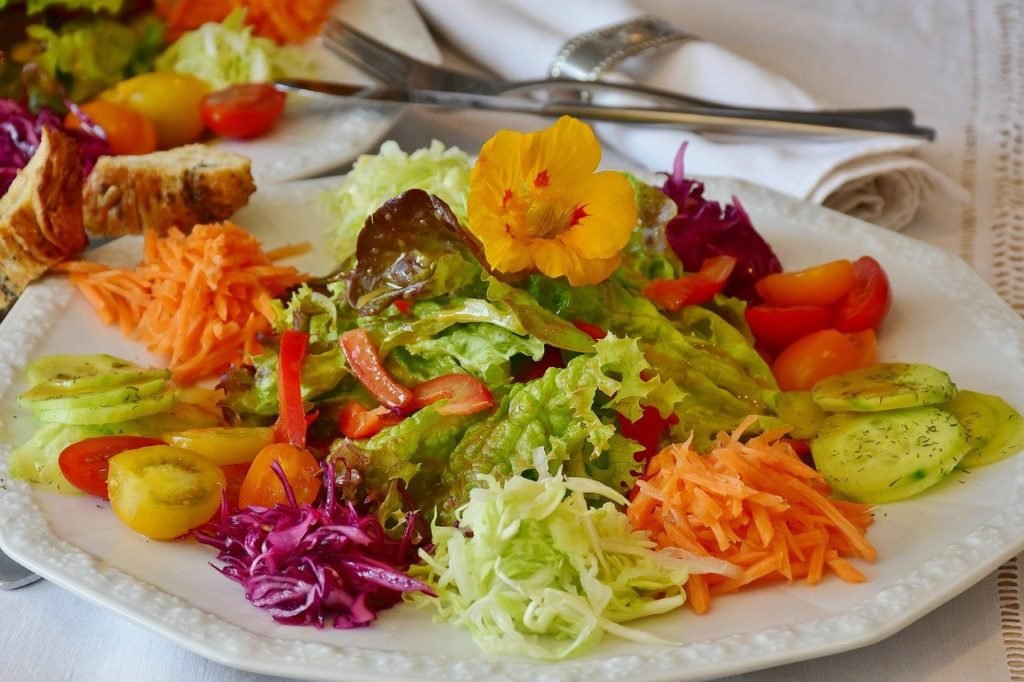“Allow your healthy salad to remain healthy!”
A salad when made right, can be a healthy meal to consume. It will give you carbohydrates for energy, protein, and essential healthy fats. But when you choose poor fat quality, sugar, and sodium-laden salad dressings the healthy quota of that meal reduces, so choosing a good fat, low sugar and low sodium salad dressing plays an important role in contributing to your health. Let’s see what these are, why are they important and how can you use include them in your daily life

What is low sodium salad dressing and how to identify it?
Since a salad can be considered less palatable, salad dressings were made to improve the taste and palatability so people enjoyed eating ‘healthy’. But the downside to this was the inclusion of salt- which is rich in sodium to make it tasty since it enhances the positive sensory attributes of food.
Since increased sodium intake has negative health impacts, a need for tasty but low sodium dressings came into play. A low sodium salad dressing is a salad dressing that reduces the amount of sodium-containing ingredients like salt, monosodium glutamate, soda and thus reducing the overall sodium content of that product
So, while buying a salad dressing, always read the ingredients and nutritional label to identify whether it is low in sodium. Here are some ways to do it:
- Know the daily value of sodium: The daily value is the reference amount of daily intake level of a nutrient that is considered to be sufficient to meet the requirements and should not exceed this. The daily value of sodium for a healthy adult is less than 2,300 mg/day. For those with pre-hypertension or hypertension, it shouldn’t exceed 1500 mg/day
- Understand % Daily Value (DV) and use it as a tool: % DV is used to describe how much does a nutrient in one serving size contribute to the daily nutrient needs, so you can use this to determine whether a product is high in sodium or low. E.g., The %DV of sodium in one serving size is 15%, which means that consuming one serving will meet 15% of your daily requirement of sodium
- 5% DV or less sodium per serving is considered low sodium
- 20% or more sodium per serving is considered high sodium
- Consider the serving size: As mentioned, the daily value is mentioned as per serving sizes, so consider how many servings sizes you’re consuming to determine your sodium intake.
- Check the package for nutritional claims and then confirm by reading the nutritional label. Here are some common claims and what they mean according to the FDA:
| Nutritional Claims | What It Means |
| No Salt/ Salt or Sodium Free | Less than 5 mg sodium per serving |
| Very Low Sodium | 35 mg of sodium or less per serving |
| Low Sodium | 140 mg of sodium or less |
| Reduced Sodium | At least 25% less sodium than the regular products |
| Light in Sodium or Lightly Salted | At least 50% less sodium than the regular products |
| No- salt-added or unsalted | No salt is added during processing – but these products may not be salt/sodium-free unless stated |
Table 1: Nutritional Claims and their meaning
Also Read: The 10 best foods to lower your cholesterol
Why do you need low sodium salad dressing?
In today’s world, with ready-to-go products and packaged foods, all containing high amounts of sodium the average sodium intake of an American 2 years or older is 3,400 mg or more. Higher than required sodium consumption is associated with negative health impacts.
Research has well established a strong link between sodium intake and blood pressure, excessive sodium consumption causes a significant increase in blood pressure, and increases the risk of hypertension and other cardiovascular complications. A study showed that increased sodium consumption also increases the risk of strokes. It also affects other organs like the heart, blood vessels, kidneys, and brain negatively.
Research has also shown high sodium consumption is linked with increased inflammation and adiposity independent of total energy and sugar-sweetened beverage intake. An increase in inflammation also harms our immune system.
Moreover, studies show that reducing sodium intake not only reduces blood pressure and incidence of hypertension but also reduces cardiovascular morbidity and mortality, as well as reduces the risk of strokes.
So not only is high sodium intake harmful but reducing it is actually beneficial to our health, and thus choosing a low sodium salad dressing can be a step in that direction.
Alternatives to salt
When preparing salads at home, you can control the ingredients of the salad as well as the dressing and make the healthiest version. To make low sodium salad dressings at home you can reduce the amount of salt you add in it and substitute it with ingredients like lemon juice, ginger, garlic, basil, pepper, cumin, parsley, rosemary, basil, dry mustard, onion powder, tarragon to maintain the taste and make it flavorful.
Apart from high sodium content, salad dressing may also have a lot of sugar and poor-quality fats which can contribute to unhealthy and unnecessary calorie intake. Let’s see how to work around that.
Low-Calorie Salad Dressing
When you make salad dressings at home you can control the ingredients as well as the quantity of ingredients used, thus homemade salad dressings are usually lower in calories than ones available in the market. But, in this fast-moving world, not everyone has time to make meals at home, so there are low-calorie options available as well. In high-calorie dressings like mayonnaise and Italian salad dressing, usually, the amount of oil content is reduced. This comes with a change in texture and palatability, to overcome this fat replacers are used like maltodextrin and xanthan gum. These are ideal for those who are on a calorie deficit diet or anyone looking to cut back on unnecessary calories.
Sugar-Free Salad Dressing
There are sugar-free salad dressings available in the market. Reducing or eliminating sugar from your salad dressing is an effective strategy to reduce your overall simple carbohydrate intake since it may affect your health negatively. The best way to identify low sugar or sugar-free salad dressings is to read the ingredient list and nutritional information and look out for the following:
- Ingredients: Check the ingredients for the presence of sugar, honey, maple syrup, or hidden names like glucose, liquid glucose, dextrin, high fructose corn syrup, fruit juice concentrates, etc. In addition to that also see the order of ingredients, if any of these are ahead in terms of order it means that they are used in a higher amount.
- Understand Total Sugars and Added Sugars: Total sugar considers both natural sugar of food like milk sugar, fruit sugar, etc. as well as added sugar which you get from tabletop sugar, honey, maple syrups, etc. The lower the added sugar the better.
- %DV for Added Sugar: Just like sodium, added sugar also has a % DV, you can check if the product is low or high in sugar
- 5% DV or less is a low source of added sugars
- 20% or more is a high source of added sugars
Is Italian Dressing Healthy?
Italian Salad Dressing may be vinaigrette-type or creamier. The vinaigrette one is a mix of oil, lemon juice, and vinegar whereas the cream-based one has milk products like cheese, mayonnaise, cream, etc. The vinaigrette ones are healthier. For it to be further healthy choose one that uses oils like olive oil as their base since they have healthy fats, low sodium, and low sugar as explained above. You may also opt for the lower-calorie ones if need be. While preparing it at home, you can again make it healthier by using olive oil and adding less salt and honey, you can also add garlic, basil, lemon juice, and apple cider vinegar to make it healthier and tastier.
Salad Dressing Options Available
Now that you know the importance of choosing low sodium, low sugar, and low calorie (when high in poor quality fats) as well as how to identify them let’s see some options available in the market
- Annie’s Balsamic Vinaigrette
Nutritional Information: 2 Tbsp contains
Energy- 100 Kcal
Total Fat- 10 g
Carbohydrates- 2 g
Sodium- 60 mg: 2% DV
This is a full-fat dressing but the source being is low in saturated fats and high in healthy fats like MUFAs and PUFAs. It has no added sugar and based on the %DV is low in sodium. If you are worried about the calories, you can consume 1 tbsp instead of two
- Bolthouse Farms Organic Three Herb Vinaigrette
Nutritional Information: 2 Tbsp Contains
Energy- 50 Kcal
Total Fat- 4.5 g
Carbohydrates- 2 g
Added Sugar- 1 g: 2% DV
Sodium- 120 mg: 5% DV
This is a flavorful dressing with 64% lower calories, low fat, low added sugar, and low sodium.
- Newman’s Own Sesame Ginger Dressing
Nutritional Information: 2 Tbsp Contains
Energy- 35 Kcal
Total Fat- 1.5 g
Carbohydrates- 5 g
Sugar- 4 g
Sodium- 290 mg: 13% DV
This salad dressing is low in calories and fat, although a little higher in sodium it is a good choice to get some different flavors in your diet, you can also have a reduced serving size to reduce sodium intake
- Primal Kitchen Lemon Turmeric Vinaigrette
Nutritional Information: 2 Tbsp Contains
Energy- 100 Kcal
Total Fat- 10 g
Carbohydrates- 2 g
Sodium- 120 mg: 5% DV
This is a full-fat dressing, but the base is avocado oil which is a source of healthy fats, it is low sodium and sugar-free salad dressing. The calories come from good quality sources but if you’re worried about it you can have a reduced serving size
- Tessemae’s Organic Classic Italian
Nutritional Information: 1 Tbsp Contains
Energy- 80 Kcal
Total Fat- 9 g
Carbohydrates- 0 g
Sodium- 50 mg: 2% DV
This is a healthier Italian dressing, note that the serving size is 1 tbsp because it is comparatively calorie-dense, the calories are from a healthy source of high oleic sunflower oil, furthermore it has no sugar and low sodium content.
Conclusion
It is beneficial to consume low sodium salad dressing, and even better to consume one with no sugar and healthy fats. The best way is to have it home-made, but in case you cannot there are plenty of options available and now you know how to identify them.
References
- Henney J, Taylor C et al. (2010) 2 Sodium Intake Reduction: An Important but Elusive Health Goal. National Academy of Sciences. https://www.ncbi.nlm.nih.gov/books/NBK50951/?report=reader
- Sodium in Your Diet: Use the nutritional facts label and reduce your intake. (2021) Food Facts U.S. Food & Drug Administration https://www.fda.gov/media/84261/download
- U.S. Department of Health and Human Services and U.S. Department of Agriculture. 2015 – 2020 Dietary Guidelines for Americans. 8th Edition. December 2015. Available at https://health.gov/our-work/food-nutrition/previous-dietary-guidelines/2015.
- Sodium | cdc.gov. (2021, December 21). Centers for Disease Control and Prevention. https://www.cdc.gov/heartdisease/sodium.htm#:%7E:text=The%20body%20needs%20a%20small,for%20heart%20disease%20and%20stroke.&text=Most%20of%20the%20sodium%20we%20consume%20is%20in%20the%20form%20of%20salt.
- Grillo, Salvi, Coruzzi, Salvi, & Parati. (2019). Sodium Intake and Hypertension. Nutrients, 11(9), 1970. https://doi.org/10.3390/nu11091970
- Gardener, H., Rundek, T., Wright, C. B., Elkind, M. S., & Sacco, R. L. (2012). Dietary Sodium and Risk of Stroke in the Northern Manhattan Study. Stroke, 43(5), 1200–1205. https://doi.org/10.1161/strokeaha.111.641043
- Farquhar, W. B., Edwards, D. G., Jurkovitz, C. T., & Weintraub, W. S. (2015). Dietary Sodium and Health. Journal of the American College of Cardiology, 65(10), 1042–1050. https://doi.org/10.1016/j.jacc.2014.12.039
- Dietary Sodium, Adiposity, and Inflammation in Healthy Adolescents. (2014). PEDIATRICS, 133(3), X34. https://doi.org/10.1542/peds.2013-1794d
- Amirkavei S, Fatemi H. et al. (2004). Production of low-calorie dressings. Journal of Science and Technology of Agriculture and Natural Resources. 8(3) 181-191
- Center for Food Safety and Applied Nutrition. (2022a, February 25). Added Sugars on the New Nutrition Facts Label. U.S. Food and Drug Administration. https://www.fda.gov/food/new-nutrition-facts-label/added-sugars-new-nutrition-facts-label





